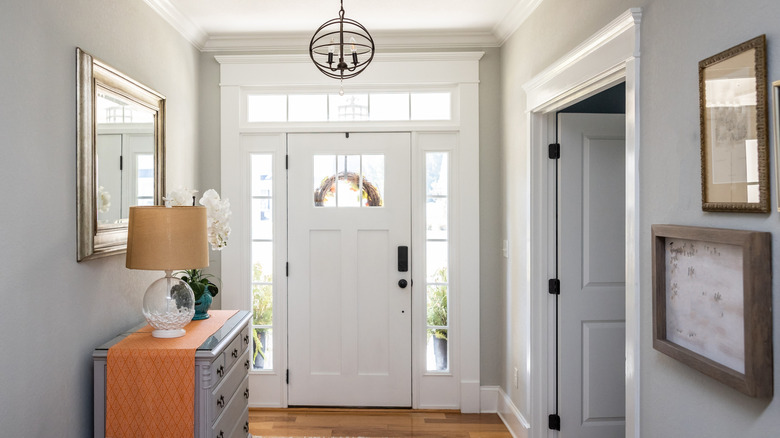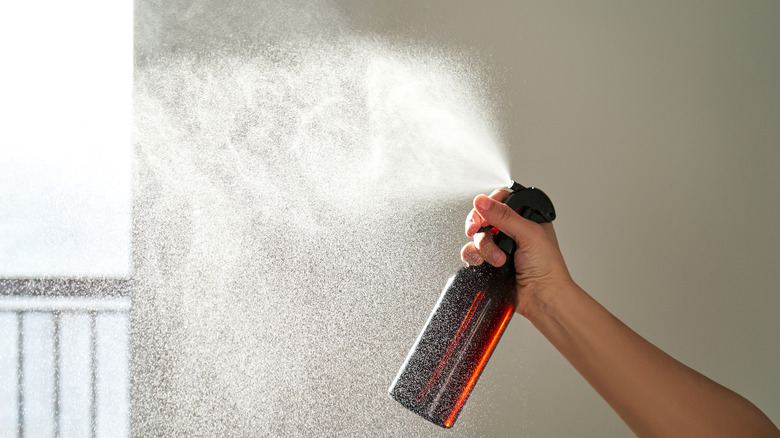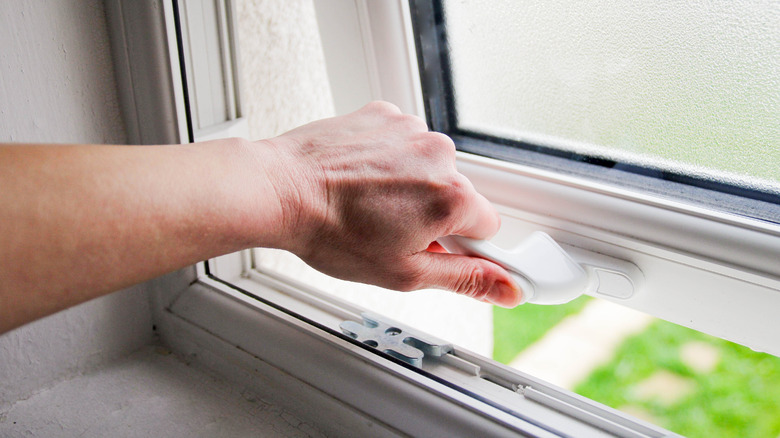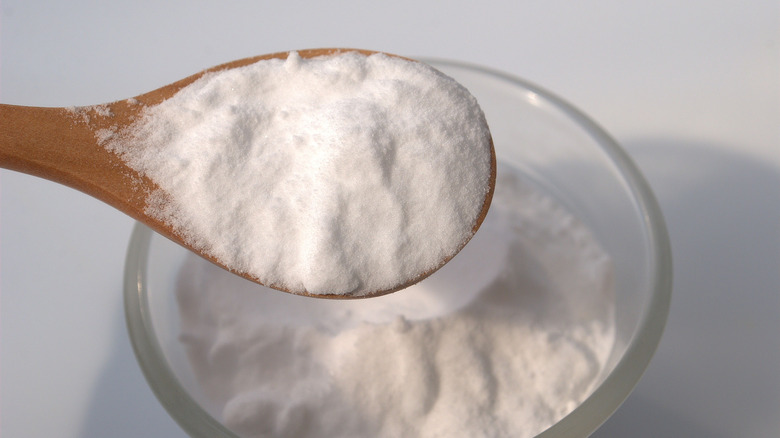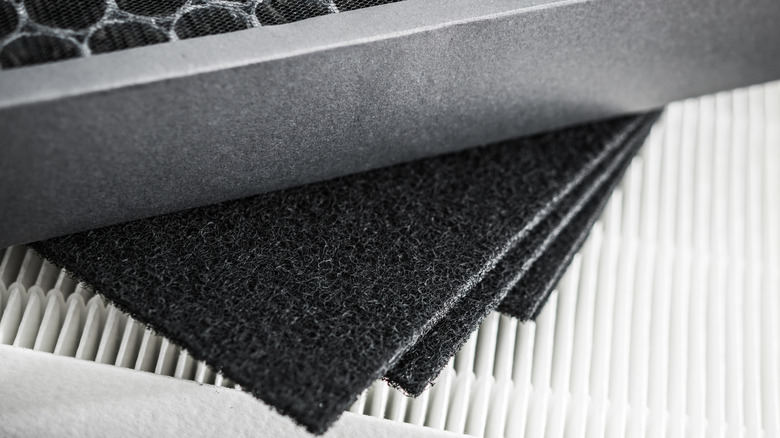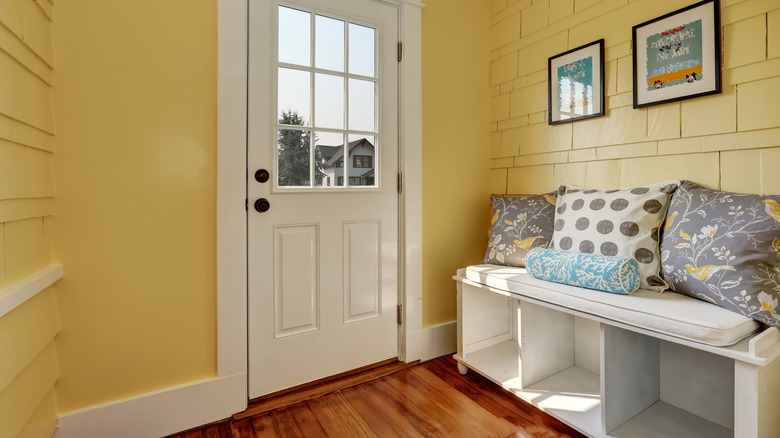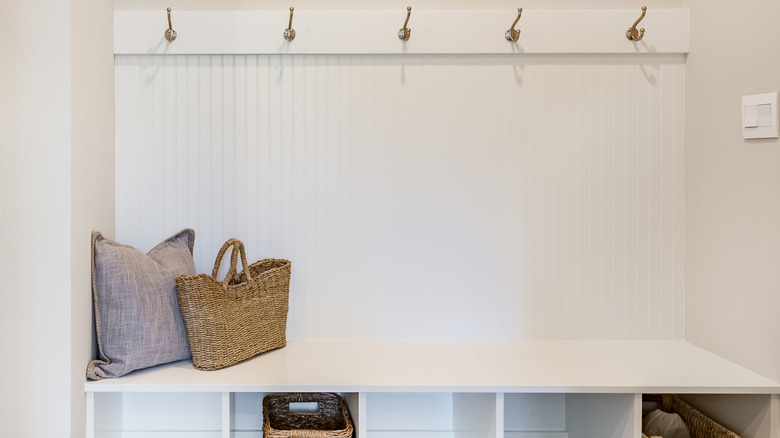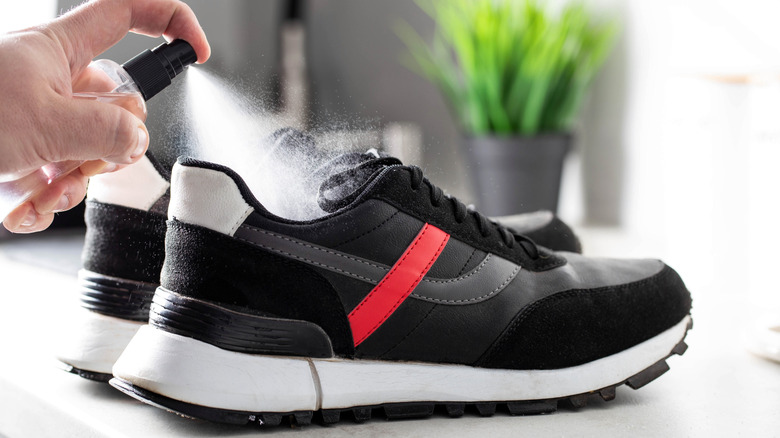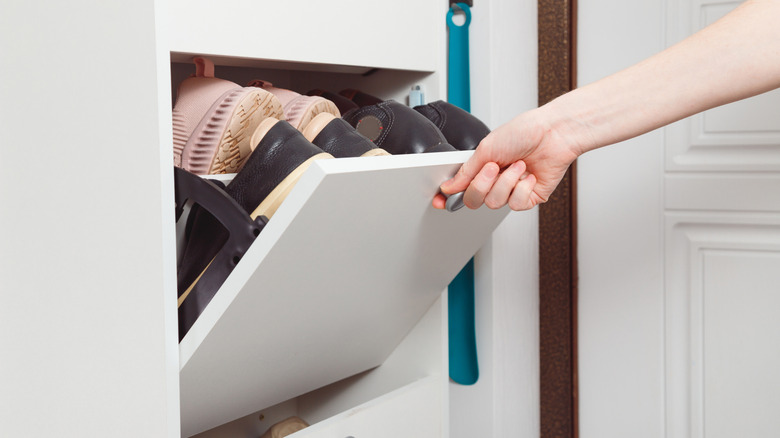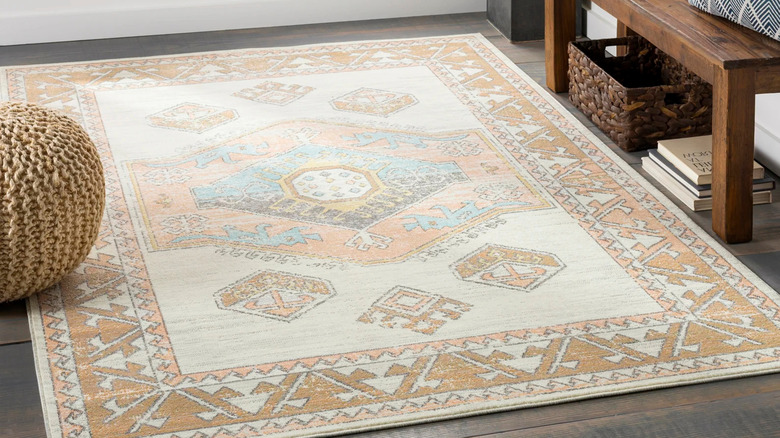Eliminate Funky Smells From Your Entryway With These Tips
We may receive a commission on purchases made from links.
You only get one chance at a first impression, so having an entryway that doesn't stink is essential for setting the scene for your home. For the freshest-smelling space, what's most important is that you really get to the root of the problem and don't just try to cover it up. Sure, it's nice to have fragrant plants on display or to light a nice candle or two, but it's only a matter of time before the stench of pet dander, stinky shoes, or wet welcome mats takes over completely.
Instead, invest time to eliminate funky smells from your entryway forever with these tips. Most of the tips are preventive and don't require any DIY experience. Even better, you can take care of a majority of them in just one afternoon. So, whether you have a big event coming up, or the smell is just driving you crazy, it can be completely gone before you know it.
Deodorizing spray is a great option for cleaning up in a pinch
If you notice a foul smell when you don't have much time to do a thorough clean, such as when company is on its way, there is luckily a quick solution. In these instances, reaching for a deodorizing spray, like Febreze Air Freshener Spray, works well. This is because sprays like these aren't just perfume for the air. Rather than just masking whatever stinks, they work to get rid of it. Check the ingredients on the bottle: Most brands will contain beta-cyclodextrin, which is a hoop-shaped molecule. The inside of the ring hates water (meaning, it's hydrophobic), but the outside loves it. Luckily, most odors are also hydrophobic, so they're drawn to the inside of the ring.
Being constructed this way means that when the stench from pet dander or dirt comes into contact with the molecule, it gets sucked into and stuck in the hollowed-out donut hole. In doing so, the foul scent can no longer attach to your olfactory sensors. This doesn't make it disappear, but it does make it so you can't smell it anymore. If you are worried you've gone nose blind to stinky shoes, an old rug, or even the overall dampness of a humid house, sprays are a great quick fix. However, to truly eliminate smells, you will need to circle back for a deeper clean when you have the time.
Open windows to circulate the air
There is nothing quite like fresh air! In fact, countries like Germany even have a special name for an open-window practice for fresher indoor air: Lüften. It means "airing" or "to ventilate" in English. The idea is to simply circulate the air in your home. If you use a central HVAC system regularly, it's likely not often that fresh air from outside gets to come in, so if things in the entryway are a little stinky, airing out your home is definitely worth a try. "The correct way to ventilate a home is to employ the Stoßlüften, or shock ventilation method," Raymond Galvin, a researcher at the University of Aachen and Cambridge, told Politico. "You open your windows completely for three minutes if it's windy, five to 10 minutes if it's not." If your entryway doesn't have a window, consider opening the door and monitoring the space until you can lock up again.
The fresh air comes in, the stale, stinky air goes out — and suddenly your entryway is fresh again. This way you don't have to worry about the chemistry of removing the smell from the air — you're just getting rid of it altogether. If you are dealing with something particularly jarring, like a smoky smell or pet mess, consider temporarily adding a little boost with a fan, like the LEVOIT Tower Fan, to really get things moving.
Use baking soda, because sometimes the best scent is no scent at all
For the smell-sensitive, even something lovely like lavender or crisp apple might make you wrinkle your nose. If this sounds like you, when eliminating funky smells from your entryway, reach for natural and non-toxic cleaning ingredients — ones that don't leave behind their own unpleasant smells or residue. This way, things smell clean because there's no detectable scent at all — and you don't risk mixing the scents of humid pet dander with lingering sandalwood from your cleaning spray. This is where baking soda comes into play.
Also known as sodium bicarbonate, this substance works so well because it helps to balance the pH of what it touches. It is mildly alkaline, so when it touches something acidic (which sour smells tend to be), it pulls it more towards neutral, which makes it stink less. The same goes for scents that are on the basic side. Essentially, baking soda is a master neutralizer. You can sprinkle it on fabrics in the entryway like carpets, pet beds, or even on shoes to help with the smell. The best practice is to leave it to sit and absorb for about 15 minutes, then vacuum it (and the stink!) right up.
Activated charcoal can vanquish smoky smells
Smoke is an odor that's hard to shake — and having it in your entryway doesn't make for a good impression. Whether you live in a home that's seen some heavy smoking in its day, or perhaps are dealing with a temporary influx of smoke from local disasters or even a neighbor's backyard bonfire, there is an easy way to get rid of stubborn smoke odors: activated charcoal.
The substance works very similarly to baking soda in terms of neutralizing odors, except activated charcoal does so by absorption. Its surface attracts odor molecules, preventing them from staying in the air and reaching your nose. But that's not its only superpower. As the charcoal is porous rather than flat, it has a lot more surface area, meaning it can absorb a ton more smells. This means a little bit of activated charcoal can go a long way, making it a powerful odor-trapper.
You can place a bowl of activated charcoal in your entryway or get pre-made bags such as the Delfori Activated Charcoal Odor Absorber Bags. However, that's not the only approach. You can also swap out your air filters with an activated carbon or activated charcoal filter, like the Filtrete Odor Reduction Air Filters. These names are interchangeable. In a pinch, you can even attach one of these filters to a box fan for a makeshift air purifier.
Pay close attention to smelly fabrics
You can scrub and deodorize all you want, but if you aren't washing the fabrics in your entryway, it's always going to stink — at least just a little bit. Plan to wash any textiles at least quarterly, even if they don't look visibly dirty. Take down your curtains, remove pet beds and leashes, and unzip the covers on the bench throw pillows. The welcome mat should also be in the mix. Be sure to check the laundry codes on the individual labels, but a simple wash and dry should work wonders for most items.
There are a few exceptions to this. First is if any of the fabrics are covered in mold or mildew. Both of these present a strong musty smell due to the volatile components of the fungi. Experts recommend laying the fabrics flat on a surface to dry and eliminate any moisture, as humidity is a breeding ground for fungi, then vacuuming them. If the mold or mildew is not coming off, you can typically loosen the growth's grip on the fibers with a toothbrush or other brush with stiff bristles. Second, if the cushions don't have covers and will need to be cleaned as a whole, you'll need to double check their specific care instructions. That's because there is a proper method for washing different pillows. For example, a down pillow can be washed on your machine's gentle cycle, while a silk-covered pillow can't be washed with water at all, because it will damage its material. Instead, it should be vacuumed very, very thoroughly to remove foul smells.
Invest in a drying rack for wet items
Many smells in the entryway can be attributed to wet items. You can do a lot to make the entire space smell better by simply keeping shoes, raincoats, and other clothing hung in this area dry, as this cuts down on the presence of stinky mildew growth. Mildew smells so bad because of microbial volatile organic compounds (mVOCs), which reproduce quickly and are quick to travel through the air. By keeping things dry, these mVOCs won't form.
The best way forward here is to invest in airy storage solutions for your entryway. For example, a coat rack is not only a great way to clear up clutter and organize your entryway, but it also provides a place to air out wet items. Open shoe racks, like the Kitsure Shoe Rack, let stinky shoes have the airflow they need to dry off and air out. However, if you live somewhere with a particularly wet climate and think your shoes might need an extra bit of help, there are even drying racks that heat shoes to dry them, like the FORLIM Boot Dryer.
Deodorize smelly shoes with vodka
Wildly enough, you can use vodka to help get rid of the stink on your shoes. This is because alcohol can literally change the shape of the proteins in bacteria, which can cause bad smells. Once the shape is changed, bacteria begin to die, thus reducing the smell. The alcohol in vodka also acts as a drying agent, taking the odor molecules with it as it evaporates.
If you have vodka around and a particularly smelly set of shoes, just pop the alcoholic liquid into a spray bottle and give your shoes a light misting. If you are still feeling skeptical, it may be encouraging to know that even Martha Stewart swears by this deodorizing hack. Be sure to choose unflavored vodka, because the flavoring typically has lots of sugar in it, which will just make your shoes sticky.
Closed-off shoe storage is essential to cut down on stink
Even when dried off and deodorized, shoes can sometimes still just stink! If you don't have the time to clean your shoes, or find that doing it often is too much of a hassle, the easiest way to cut down on smells in the entryway is to invest in a closed storage solution. This way, any wayward smells are trapped inside the cabinet and you don't have to worry about them leaking out and ruining the vibe. However, footwear should only be stored here once it has properly dried, as the dampness has a higher chance of developing into mildew in a closed space with no air circulation.
IKEA has a great option: the popular TRONES shoe cabinet. The two cabinets open forward and have room for about two pairs of adult shoes on each level. Other options are available on Amazon, like the HOMIDEC Shoe Rack. It has three shelves with two tiers each and doors that open outwards, which some might find more convenient. These pieces are sleek and modern, both keeping shoes concealed and not overwhelming your entryway with bulky furniture.
Regularly clean entryway rugs and mats
Having a rug or welcome mat in your entryway could be a smelly culprit. Unlike stone or hardwood, rugs and mats are made of fabric, which can trap scent molecules. This is especially true if your entryway happens to be carpeted. If you do have carpet, you may want to consider replacing it with non-fibrous flooring. Otherwise, regular cleaning of the textiles should help keep odors at bay.
Vacuum any larger rugs in your entryway at least two times a week. If this sounds like too much of a chore, consider investing in a robot vacuum, like an iRobot Roomba. Aside from vacuuming, entryway rugs should be washed about monthly. Some can just be popped in the washing machine, but others — like jute or wool rugs, for example — might need to be treated more carefully and require the help of a professional.
